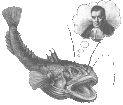UW Aquatic & Fishery Sciences Quantitative Seminar
Lingbo Li
School of Oceanography, University of Washington
Diet estimation using stable isotope mixing models: where are we?
Abstract
Stomach contents have long been used to obtain fish diets. However, for small lakes, you may need to deplete almost the whole population of top predators such as lake trout (Salvelinus namaycush) to obtain enough representative stomachs. Fortunately, the rapidly developed stable isotope mixing models make non-lethal diet estimation possible. Here I use the small Lake 373 of the Experimental Lakes Area, Ontario, Canada, as an example to apply the Bayesian mixing models to reconstruct diet composition of lake trout based on stable isotopes. δ15 N and δ13 C analyses were carried out for lake trout clips and for all their potential prey including invertebrates (whole body) and forage fish (muscle). The increase of δ15 N ratio of lake trout is shown as a function of fish length and lake trout diets are estimated for different size groups in addition to overall diets. I evaluate the model results using expert knowledge and limited samples of lake trout stomachs and carry out uncertainty analyses with emphasis on trophic enrichment factors. Finally I discuss the strengths and limitations of Bayesian mixing model, which is applicable for any animals.

